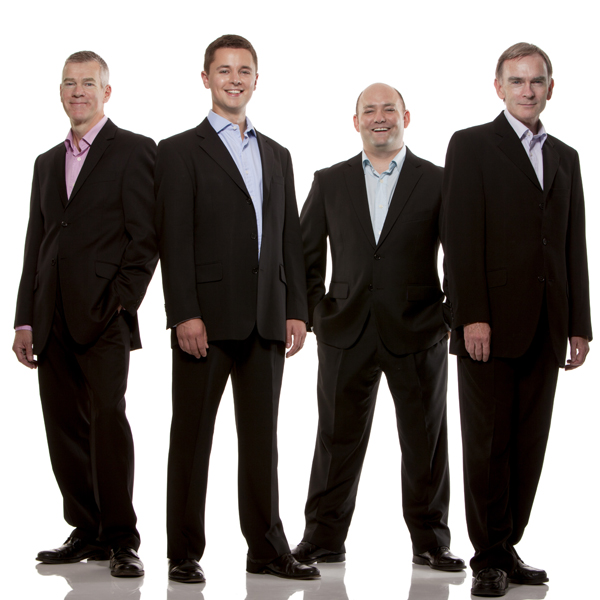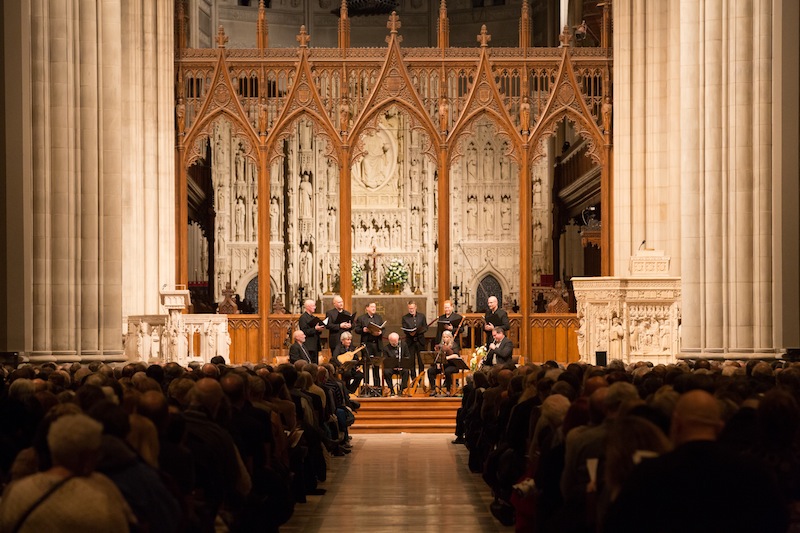Orlando and Folger Consorts make beautiful medieval music together

The Orlando Consort performed with the Folger Consort Friday night at Washington National Cathedral. Photo: Eric Richmond
For its annual Epiphanytide concert at Washington National Cathedral, the Folger Consort often collaborates with a celebrity ensemble. This year it was the Orlando Consort, the British male vocal quartet that last performed here a decade ago.
Heard on Friday evening, the program consisted largely of rarely heard, late medieval polyphony from the Old Hall Manuscript, the sort of repertory that is the principal glory of early music ensembles. The hearts of archivists, musicologists, editors, and specialists in early music alike thrill whenever the stars align and this forgotten music is performed again.
The venue, a building modeled on English Gothic cathedrals, offered a most appropriate setting for the music recorded in this unusual book. The Old Hall Manuscript is a legendary source, the earliest collection of English polyphony to survive both the passage of time and the attempts of the English Reformation to erase English Catholic church music from history. As scholar Margaret Bent showed in her groundbreaking dissertation the book was written in layers in the early 1400s. The Chapel Royal may have used the book at some point, for it contains music attributed to “Roy Henry” (probably Henry V) and music created to commemorate that king’s remarkable victory at Agincourt during the Hundred Years’ War.
In some of the pieces the members of the Orlando Consort performed without instrumental doubling, which was most likely the manner of performance in the late Middle Ages. As if to prove the point, these pieces, like the Sanctus by Roy Henry and the Agnus Dei by Richard Chirbury, had the most beautiful sound. The two newest members of the group, countertenor Matthew Venner and tenor Mark Dobell, could project their voices with the greatest clarity in these sparer textures. Venner, always light-filled and sweet, stood out for particular praise.
The group was most effective when all parts had text to sing. In some of the pieces, the lower parts have only long melismas, as in the Credo by Leonel Power and the Gloria by Gervays. The Orlando Consort often sang these parts on a neutral vowel, almost a hum with the mouth closed or semi-closed, subordinating the textless parts to the ones with text in a way that unbalanced the overall sound. That performing choice made more sense in the multi-texted motets, like Damett’s Salvatoris Mater/O Georgi/Benedictus Mariae Filius, where it reduced somewhat the confusion created by two texts being declaimed simultaneously. On the other hand, that profusion of words is one of the delights of the medieval motet repertory.
Instrumental contributions from the Folger Consort and two guest musicians were less felicitous. The mismatched group of instruments, including recorder, medieval fiddle (presumably different sizes of vielle), citole, and recorder, did not always balance well among themselves or in combination with the singers. The difference was especially noticeable in the opening piece, a Gloria by Pycard, with some sections performed by voices alone and some with instruments.
In particular, the use of the sackbut, or early trombone, seemed anachronistic, as the earliest evidence of the instrument’s existence postdates the music found in the Old Hall Manuscript. The little dance pieces and carols performed by instruments alone had a number of uncertainties in performance, including a misalignment that eventually required a restart in one of the Estampies in the first half.
The problems of the cathedral’s cavernous acoustic will always be difficult, at least with this kind of small group placed at the crossing. The intended location for singers in this kind of space, the choir, would almost certainly be an improvement, because of the backing of stone in that part of the building, but the number of ticketed seats there would be too small. Even in this arrangement, from seats close to the performers the sound in the larger and later pieces from the collection was quite beautiful.
The addition of a drum unified and enlivened the entire ensemble’s performance of the Agincourt Carol, celebrating Henry V’s victory (“the fray / that France shall rue till Doomesday”).
A motet in honor of St. Anne, John Plummer’s Anna mater matris Christi, and two gorgeous motets by John Dunstaple were the highlights of the second half. In the unaccompanied Descendi in ortum meum, set by Dunstaple on words drawn from the erotic Biblical Song of Songs, the pleading repetition of the word Revertere (Return!), overlapping in the voices, was especially moving.
Dunstaple’s sprawling, complex motet Veni sancte spiritus/Veni creator spiritus, composed for the ceremony in Canterbury Cathedral marking the victory at Agincourt, is one of the masterpieces of music history. The combined forces rendered this music in a way worthy of the composer’s great achievement.
The program will be repeated 7 p.m. Saturday. folger.edu/events/medieval-illuminations; 202-544-7077.

Photo: Teresa Wood



Posted Jan 07, 2017 at 6:28 pm by Laura Youens
Nice to see you last night, Charles, and I concur with everything you’ve written. It was such a pleasure to hear this rare repertory live!
Posted Jan 10, 2017 at 2:52 pm by Dan
Thank you for the balanced and forthright review. Speaking as the player of the sackbut, the use of the instrument on this program was an instance of musical practicality taking priority over historical purity. While the slide trumpet would have been a more correct choice for this repertoire, we performed many of the pieces on the program in lower keys than they were originally written in order to better suit the rich, all-male vocal timbre of the Orlando Consort. Unfortunately this situated some of the parts below the range of either slide trumpet or vielle, and so sackbut was chosen as a practical (if slightly anachronistic) alternative for doubling some of the lower vocal lines.
This kind of decision is often tricky to make when performing Medieval and early Renaissance music; as you mentioned, such approaches as singing tenor lines without text and doubling voices with instruments are still topics of active debate among musicians and musicologists.
Our hope as performers is to balance these considerations in such a way that the end result is emotionally and artistically satisfying to a 21st-century audience, while still retaining a historically-informed aesthetic.